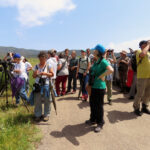Good idea in the wrong place
Last December 27th, 2021 it was published in the DOG (Diario Oficial de Galicia or Galicia’s Official Journal in English), the “AGREEMENT of 21 December 2021, of the Xefatura Territorial de Lugo, which submits to public information the application for prior administrative authorisation and construction of a photovoltaic solar plant in the municipality of Vilalba (file LU-2021-03)”. The company Tecnorenova Solar SLU, based in Vilalba (Lugo), intends to install a 750 kW photovoltaic solar plant ‘FV Porto Barroso’ on rural land, consisting of 1872 panels of 1,10 x 2,38 m mounted on fixed structures or tables facing south and with a system of movement on an axis of +/-60º to take advantage of solar incidence and a transformation centre. The installations would occupy 1.58 of the 2.29 ha of the plot.

Plot of land where the photovoltaic solar plant is to be installed. Image reproduced from SIGPAC (MAPAMA) 
Solar photovoltaic plant in Arnosa (Sanxenxo, Pontevedra). Image reproduced from SIGPAC (MAPAMA)
This is yet another example of perversion of the best alternatives to decarbonise the economy and fight climate change. It seems that some renewable energy promoters are bent on turning every possible solution into a new environmental problem.
SGHN’s reasons for standing against the project
Under the auspices of the International Union of Soil Science and with the unanimous support of the FAO Conference, the General Assembly of the United Nations established December 5th as World Soil Day. It has been celebrated since 2014 to disseminate the importance of healthy soils and to advocate for their sustainable management.
In the information materials published for World Soil Day 2016, the FAO highlighted the negative impacts of soil sealing or “Permanent covering of the soil surface with artificial impermeable material”:
- Irreversible loss of soil.
- Loss of food and fibre production.
- Significant or total loss of water retention in the soil.
- Reduction of neutralisation and purification capacity.
- Reduction of carbon sequestration capacity.

Healthy soils and their sustainable use are essential to achieve 7 of the 17 UN Sustainable Development Goals. Both the EU Thematic Strategy on Soil Protection and the European Parliament’s Motion for a Resolution on Soil Protection (2021/2548(RSP)) stress the urgent need to prevent or minimise soil sealing with the aim of not fully occupying the land by 2050.
Take good ideas to the right places
Given that there are hundreds, if not thousands, of hectares of roofs in Galicia which could house photovoltaic solar panels on various types of buildings (industry, farms, sports centres, etc.), as well as on buildings in areas with no heritage value, it is totally absurd and unacceptable to destroy natural or cultivated land (a non-renewable resource on a human timescale) in order to install photovoltaic solar plants, however renewable this type of energy may be.
In addition, by bringing together production and consumption sites and also in areas that already have electricity infrastructure, the installation of solar PV panels on the roofs of buildings would minimise the need for new medium or high voltage lines to evacuate the electricity produced.

High voltage line in ZEC Canón do Sil.High voltage line in ZEC Canón do Sil. 
High voltage line in ZEC Canón do Sil.
Text translated by David Forján Castro (student of the Degree of Translation and Interpretation of the University of Vigo)






